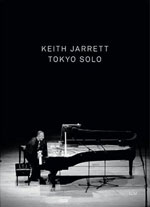Home » Jazz Articles » Film Review » Keith Jarrett: Tokyo Solo
Keith Jarrett: Tokyo Solo
 Keith Jarrett
Keith Jarrett Tokyo Solo
ECM
2006
It's easy to ridicule Keith Jarrett, who gives his detractors no shortage of ammunition. Notorious for his physical gyrations, orgasmic moans and facial contortions, Jarrett will also abruptly stop a performance should anyone cough. He routinely provides cough drops for the audience and even organises "group coughs," to prevent his creativity being disrupted.
Many people find it hard to get beyond Jarrett's over-the-top tics and affectations, which they see as rising (or perhaps falling) to the level of a prima donna's comic burlesque. Miles Davis—who could be pretty temperamental himself—once asked, with acid tongue firmly in cheek, "So, Keith ... how does it feel to be a genius?"
That said, there's no denying the immensity of Jarrett's talent, some of which this video reveals. It consists of previously unreleased material from a 2002 concert, Jarrett's 150th performance in Japan, where he has found a home away from home. This is no mystery, given both the Japanese's musical sensibilities, which seem more receptive to Jarrett's atonal wanderings, and their keener sense of quiet respect compared to American audiences. (That the Japanese have a cultural affinity with ritual performance may also be a factor). Speaking of his Japanese fans, Jarrett, not best known for praising his audiences, once said "It's an honor to feel [their] respect for my work...."
More than most solo piano concerts, a Jarrett performance is a visual experience. Tokyo Solo may be something of a shock for anyone who hasn't seen Jarrett in a while. He was born in 1945, and he looks every year of his age, his formerly luxuriant hair now close-cropped and grey. The camera reveals what even the audience can't see: Jarrett's hands are the gnarled, loose-skinned hands of an ageing man.
The camera also shows what can't be heard on a recording: the notes not played. At the end of "Part 2d," a gorgeously melodic ballad composed on the spot, Jarrett hits a closing chord in the lower register, positions his hands to repeat it two octaves higher (a standard pianistic device) but then pulls them away, as if to say "No, that's fine right there." A Jarrett concert—for better or worse—is always fresh-minted.
The most pleasant surprise is when Jarrett, called out for three encores after over an hour of his trademark improvisations, responds with three standards. "Danny Boy" is rendered with such exquisite tenderness that it will likely bring tears to the eyes of some listeners. "Don't Worry 'Bout Me," which closes, is perhaps Jarrett's reassurance to his Japanese fans that his lengthy and debilitating bout with chronic fatigue syndrome is now behind him.
Director Kanama Kawachi deserves honorable mention for his camerawork. Kawachi's quietly original shots enhance the video, but avoid any distractingly self-conscious efforts at artiness. Prime examples are the several shots of Jarrett's feet, which show his use of the footpedals, including the rarely used middle, often two at once.
Tracks: Part 1a; Part 1b; Part 1c; Part 2a; Part 2b; Part 2c; Part 2d; Part 2e; Danny Boy; Old Man River; Don't Worry 'Bout Me.
Personnel: Keith Jarrett: piano.
Production Notes: 110 minutes. Recorded October 30, 2002 at Metropolitan Festival Hall, Tokyo, Japan.
< Previous
It Amazes Me
Next >
Alay
Comments
Tags
Concerts
For the Love of Jazz
 All About Jazz has been a pillar of jazz since 1995, championing it as an art form and, more importantly, supporting the musicians who create it. Our enduring commitment has made "AAJ" one of the most culturally important websites of its kind, read by hundreds of thousands of fans, musicians and industry figures every month.
All About Jazz has been a pillar of jazz since 1995, championing it as an art form and, more importantly, supporting the musicians who create it. Our enduring commitment has made "AAJ" one of the most culturally important websites of its kind, read by hundreds of thousands of fans, musicians and industry figures every month.























